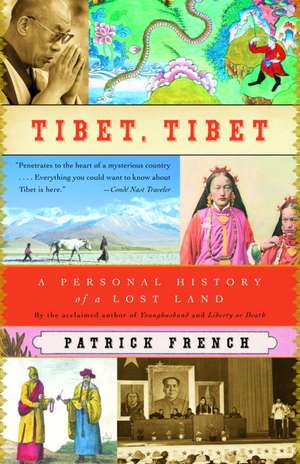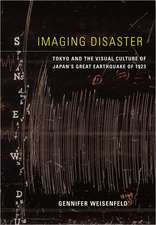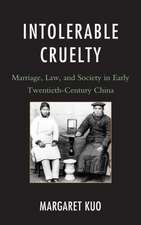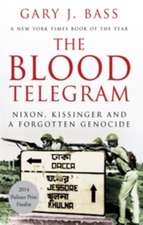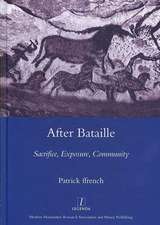Tibet, Tibet: A Personal History of a Lost Land: Vintage Departures
Autor Patrick Frenchen Limba Engleză Paperback – 31 oct 2004
Talking with nomads and Buddhist nuns, exiles and collaborators, French portrays a nation demoralized by a half-century of Chinese occupation and forced to depend on the patronage of Western dilettantes. He demolishes many of the myths accruing to Tibet–including those centering around the radiant figure of the Dalai Lama. Combining the best of history, travel writing, and memoir, Tibet, Tibet is a work of extraordinary power and insight.
| Toate formatele și edițiile | Preț | Express |
|---|---|---|
| Paperback (2) | 78.66 lei 25-31 zile | +26.74 lei 5-11 zile |
| Penguin Books – 26 ian 2011 | 78.66 lei 25-31 zile | +26.74 lei 5-11 zile |
| VINTAGE DEPARTURES – 31 oct 2004 | 108.50 lei 22-36 zile |
Din seria Vintage Departures
-
 Preț: 108.09 lei
Preț: 108.09 lei -
 Preț: 108.91 lei
Preț: 108.91 lei -
 Preț: 109.73 lei
Preț: 109.73 lei -
 Preț: 90.64 lei
Preț: 90.64 lei -
 Preț: 103.53 lei
Preț: 103.53 lei -
 Preț: 99.60 lei
Preț: 99.60 lei -
 Preț: 109.95 lei
Preț: 109.95 lei -
 Preț: 107.46 lei
Preț: 107.46 lei -
 Preț: 104.58 lei
Preț: 104.58 lei -
 Preț: 121.63 lei
Preț: 121.63 lei -
 Preț: 95.10 lei
Preț: 95.10 lei -
 Preț: 117.69 lei
Preț: 117.69 lei -
 Preț: 107.05 lei
Preț: 107.05 lei -
 Preț: 138.12 lei
Preț: 138.12 lei -
 Preț: 91.27 lei
Preț: 91.27 lei -
 Preț: 136.59 lei
Preț: 136.59 lei -
 Preț: 108.50 lei
Preț: 108.50 lei -
 Preț: 128.33 lei
Preț: 128.33 lei -
 Preț: 104.58 lei
Preț: 104.58 lei -
 Preț: 109.54 lei
Preț: 109.54 lei -
 Preț: 107.46 lei
Preț: 107.46 lei -
 Preț: 94.10 lei
Preț: 94.10 lei -
 Preț: 109.95 lei
Preț: 109.95 lei -
 Preț: 75.68 lei
Preț: 75.68 lei -
 Preț: 100.23 lei
Preț: 100.23 lei -
 Preț: 105.54 lei
Preț: 105.54 lei -
 Preț: 106.76 lei
Preț: 106.76 lei -
 Preț: 91.13 lei
Preț: 91.13 lei -
 Preț: 119.23 lei
Preț: 119.23 lei -
 Preț: 90.72 lei
Preț: 90.72 lei -
 Preț: 111.71 lei
Preț: 111.71 lei -
 Preț: 92.01 lei
Preț: 92.01 lei -
 Preț: 105.29 lei
Preț: 105.29 lei -
 Preț: 132.88 lei
Preț: 132.88 lei -
 Preț: 88.68 lei
Preț: 88.68 lei -
 Preț: 118.51 lei
Preț: 118.51 lei -
 Preț: 114.79 lei
Preț: 114.79 lei -
 Preț: 118.51 lei
Preț: 118.51 lei -
 Preț: 110.28 lei
Preț: 110.28 lei -
 Preț: 114.79 lei
Preț: 114.79 lei -
 Preț: 99.82 lei
Preț: 99.82 lei -
 Preț: 104.34 lei
Preț: 104.34 lei -
 Preț: 99.41 lei
Preț: 99.41 lei -
 Preț: 90.91 lei
Preț: 90.91 lei -
 Preț: 121.28 lei
Preț: 121.28 lei -
 Preț: 88.66 lei
Preț: 88.66 lei -
 Preț: 125.54 lei
Preț: 125.54 lei -
 Preț: 114.38 lei
Preț: 114.38 lei -
 Preț: 101.17 lei
Preț: 101.17 lei
Preț: 108.50 lei
Nou
Puncte Express: 163
Preț estimativ în valută:
20.77€ • 22.57$ • 17.46£
20.77€ • 22.57$ • 17.46£
Carte disponibilă
Livrare economică 31 martie-14 aprilie
Preluare comenzi: 021 569.72.76
Specificații
ISBN-13: 9781400034178
ISBN-10: 1400034175
Pagini: 325
Ilustrații: 3 MAPS
Dimensiuni: 143 x 196 x 20 mm
Greutate: 0.27 kg
Editura: VINTAGE DEPARTURES
Seria Vintage Departures
ISBN-10: 1400034175
Pagini: 325
Ilustrații: 3 MAPS
Dimensiuni: 143 x 196 x 20 mm
Greutate: 0.27 kg
Editura: VINTAGE DEPARTURES
Seria Vintage Departures
Notă biografică
Patrick French was born in England in 1966. He studied literature at the University of Edinburgh, and is the author of Younghusband: The Last Great Imperial Adventurer, which won the Somerset Maugham Award and the Royal Society of Literature W. H. Heinemann Prize, and Liberty or Death: India’s Journey to Independence and Division, which won the London Sunday Times Young Writer of the Year Award.
From the Hardcover edition.
From the Hardcover edition.
Extras
I was living in a small room at Tsechokling monastery, below the Himalayan village of McLeod Ganj, the centre of exiled Tibetan life. It was 1987, and demonstrations were breaking out in Tibet for the first time in decades. At the end of the summer I had to return to Europe, but for the moment I was just where I wanted to be. It was simple. Each morning I would wake early, wash in cold water, and walk down through the forest to the library above Dharamsala. The place was poor and insanitary at that time, with hunched old women clutching rosaries, and second-generation hustlers parading in slogan T-shirts and shades. There were a few post-hippie travellers, some Hindu pilgrims who came to visit the shrine at Bhagsunath, and students of Tibetan culture from places like Israel and Japan.
There was one man at Tsechokling who was attached to the monastery, but was not a monk. He lived alone in a hut he had built on the hillside, and could be seen herding cows, collecting firewood and occasionally helping out in the smoke-filled monastery kitchen. His name was Thubten Ngodup. He was quiet and shy, with a worn face that was marked with experience: he had escaped from Tibet after the Chinese Communist invasion of 1950, and worked in pitiful conditions on a road gang before joining the Tibetan section of the Indian army.
Ngodup had learned to cook when he was a soldier, and one of the monks suggested he might make a living by providing food for the occupants of the few monastery guest rooms. I was asked to help him set up the operation. We communicated in fits and starts, using fragments of shared language; looking back, I think that he felt awkward dealing with a foreigner during our fleeting, symbiotic friendship. A feasible menu was agreed (tea, soup, omelette, momo, shabalay, thukpa) which I copied out in English and distributed to likely customers. The arrangement worked well. Ngodup became dedicated to the purchase and preparation of food, anxious, maybe too anxious, in an ex-military sort of way, to provide perfect service. He had a role, and it made life easier for him.
You can see Ngodup at Tsechokling as the sun comes up over the wooden houses high on the ridge, carrying a bashed aluminium tray, on it china cups and saucers, a bowl of sugar and a beaker of hot milk, a cracked pot of tea and a plate of cooling buttered toast. He stands, leaning over the table, half-smiling and half-embarrassed, placing the breakfast things before us, bowing slightly, instinctively, in the Tibetan way. When he has finished, he picks up the tray and, holding it flat against his side, goes down the stone steps of the guest house, back towards the monastery kitchen, hitching up the patched brown trousers that hang loosely from his hips as he walks. He is forty-nine years old.
Eleven years later, during a demonstration in New Delhi, Ngodup made his choice. By his own free will, he ran to a hut where the cleaning fluids for the banners were kept, and poured gasoline across his body, drenching his clothes, his head, his hair, his face, the smell of the clouding vapour enough to make you reel. With a spark and a roar, he burst from the hut and ran into the square, blazing.
The date was 27 April 1998, just as the sun came up. Six Tibetan refugees were holding a hunger-strike at Jantar Mantar, encouraged by hundreds of supporters and frequent visits from the world’s press. The target of their protest was the poor, useless United Nations. There were several demands: a plebiscite over Tibet’s future, a rapporteur to investigate human rights abuses, and a debate on long-forgotten UN resolutions.
The hunger-strike had been going on for forty-nine days, and several people were close to death. Ngodup was in the next batch of protesters, lined up ready to replace those who died. There was a hitch: a Chinese visitor was expected. The chief of the General Staff of the People’s Liberation Army, Fu Quanyou, was arriving in India on an official visit, and the authorities did not want his stay to be marred by dying Tibetans. Indian police were told to clear the site. As day broke, the police crashed in, wielding boots and lathis, dragging hunger-strikers into ambulances and beating back protesters. Choyang Tharchin, an official from the exiled Tibetan government in Dharamsala, picked up a video camera and began to film the scuffles.
I watched the footage over and over, and each time it seemed more shocking.
Indian police are bustling about. There are Tibetans in traditional dress, more traditional than anything you would find in Tibet, and the police are shoving them, grabbing their arms, poking them with lathis. In the corner of the frame, you can just catch sight of Thubten Ngodup, pushing the wrong way through the crowd, red-faced and desperate, like a runner ending a race. He disappears from view. A minute or so later the camera moves away jerkily from the barging police and protesters, and focuses on an orange light surrounded by a white light. As the picture becomes clearer, you can make out a figure at the heart of the light, a Giacometti, moving, jumping, skipping. As the shape comes nearer, you see that this is a man, burning to death, holding his palms together in the Indian namaste greeting, moving his arms rhythmically up and down as he runs, imploring. You can see his face and just hear him shout in a reedy, high-pitched voice, above the noise of the screaming crowd, “Po Gyalo! Po Rangzen!” He turns away from the camera and moves towards the crowd of Tibetans, still framed by the orange light. Ngodup is stumbling now, dancing and stumbling, but he still holds up his joined hands towards the crowd, as if he is praying, or pleading for his life. He falters; someone acts, a policeman maybe, and pushes him to the ground. Ngodup is whacked with blankets and sacks as he cowers on the ground, shielding his head. The orange light fades, the film runs on, fixed now on the prone figure and the people running in confusion. Above the scene, you notice a hand-painted banner.
uno we want justice tibetan womens welfare group
The film flickers, and stops.
In the hospital, his nerve endings still functional, Ngodup was visited by the Dalai Lama, who told him that he should harbour no feelings of hatred towards the Chinese. Ngodup tried and failed to sit up, signalling that he had understood, and seemed happy, and died just after midnight.
Ngodup’s death shook me. There was something about its directness and logic that was hard to put from my mind. It was a very Buddhist death, a suicide bomber who turned his violence inwards, killing only himself, protecting others. Ngodup had no way to make himself heard. He was a powerless, ageing refugee in a country with enough problems of its own, so he burned himself to death, as a protest. For the Tibetan exiles and their supporters, he became a martyr, a symbol. A picture of him wreathed in flames was syndicated across the world, returning Tibet to the front pages, displacing Lewinsky and the Nasdaq, briefly.
Writing about Ngodup’s life and death, the essayist Jamyang Norbu offered an explanation for his actions.
In his last photograph taken before the hunger-strikers’ tent in Delhi, Thubten Ngodup is smiling . . . There is no hint of anger or fanaticism (or alcoholic depression) in that smile. He was a simple man (he only read Tibetan haltingly) but when I look at his photograph I feel I am seeing the calm happy face of someone who has discovered a simple truth about life; something that has always eluded our leadership, but which traditionally Tibetans have regarded as basic to any major undertaking, especially the effective practice of the Dharma—thak choego ray, you have to make a decision, and act on it.
There were things that kept him on my mind.
That he had shouted, “Po Gyalo! Victory for Tibet! Po Rangzen! Free Tibet!” even as he was being killed by flames.
That people in the crowd had said they heard popping noises as his body began to burn.
That he knew what he was doing, and why he was doing it, even as the flames consumed him.
Ngodup had always seemed such a shy, quiet man when he brought me tea and toast at Tsechokling. I had not thought of him for years until I saw his picture in the paper.*
*In a review of Tibet, Tibet published in the Indian magazine Biblio in June 2003, the BBC journalist Daniel Lak wrote that he was telephoned at home in New Delhi early on the morning of Ngodup’s death:
The voice on the line was German, speaking English with a heavy accent. The tone was frantic. “Get down here to Jantar Mantar,” the woman said, “someone is threatening to set themselves on fire . . .” A pause, then . . . “Oh God, he’s going to do it, he’s going to do it . . .” She sounded hysterical, already in tears. Still sleepy, but knowing perfectly well what my caller was talking about, I started shouting. “If you know someone is going to kill themselves then stop them, don’t expect me to put their death on television because I won’t. You disgust me.” I hung up. A few minutes later . . . Thubten Ngodup doused himself in petrol then struck a match . . . I am still angry at the foreigners who colluded in the self-immolation of an ordinary Tibetan exile. I felt there was more than an element of cynicism in the phone call I received before Ngodup’s death.
It was news to me that Ngodup’s death was foreshadowed in this way; I found the idea of such collusion deeply disturbing.
From the Hardcover edition.
There was one man at Tsechokling who was attached to the monastery, but was not a monk. He lived alone in a hut he had built on the hillside, and could be seen herding cows, collecting firewood and occasionally helping out in the smoke-filled monastery kitchen. His name was Thubten Ngodup. He was quiet and shy, with a worn face that was marked with experience: he had escaped from Tibet after the Chinese Communist invasion of 1950, and worked in pitiful conditions on a road gang before joining the Tibetan section of the Indian army.
Ngodup had learned to cook when he was a soldier, and one of the monks suggested he might make a living by providing food for the occupants of the few monastery guest rooms. I was asked to help him set up the operation. We communicated in fits and starts, using fragments of shared language; looking back, I think that he felt awkward dealing with a foreigner during our fleeting, symbiotic friendship. A feasible menu was agreed (tea, soup, omelette, momo, shabalay, thukpa) which I copied out in English and distributed to likely customers. The arrangement worked well. Ngodup became dedicated to the purchase and preparation of food, anxious, maybe too anxious, in an ex-military sort of way, to provide perfect service. He had a role, and it made life easier for him.
You can see Ngodup at Tsechokling as the sun comes up over the wooden houses high on the ridge, carrying a bashed aluminium tray, on it china cups and saucers, a bowl of sugar and a beaker of hot milk, a cracked pot of tea and a plate of cooling buttered toast. He stands, leaning over the table, half-smiling and half-embarrassed, placing the breakfast things before us, bowing slightly, instinctively, in the Tibetan way. When he has finished, he picks up the tray and, holding it flat against his side, goes down the stone steps of the guest house, back towards the monastery kitchen, hitching up the patched brown trousers that hang loosely from his hips as he walks. He is forty-nine years old.
Eleven years later, during a demonstration in New Delhi, Ngodup made his choice. By his own free will, he ran to a hut where the cleaning fluids for the banners were kept, and poured gasoline across his body, drenching his clothes, his head, his hair, his face, the smell of the clouding vapour enough to make you reel. With a spark and a roar, he burst from the hut and ran into the square, blazing.
The date was 27 April 1998, just as the sun came up. Six Tibetan refugees were holding a hunger-strike at Jantar Mantar, encouraged by hundreds of supporters and frequent visits from the world’s press. The target of their protest was the poor, useless United Nations. There were several demands: a plebiscite over Tibet’s future, a rapporteur to investigate human rights abuses, and a debate on long-forgotten UN resolutions.
The hunger-strike had been going on for forty-nine days, and several people were close to death. Ngodup was in the next batch of protesters, lined up ready to replace those who died. There was a hitch: a Chinese visitor was expected. The chief of the General Staff of the People’s Liberation Army, Fu Quanyou, was arriving in India on an official visit, and the authorities did not want his stay to be marred by dying Tibetans. Indian police were told to clear the site. As day broke, the police crashed in, wielding boots and lathis, dragging hunger-strikers into ambulances and beating back protesters. Choyang Tharchin, an official from the exiled Tibetan government in Dharamsala, picked up a video camera and began to film the scuffles.
I watched the footage over and over, and each time it seemed more shocking.
Indian police are bustling about. There are Tibetans in traditional dress, more traditional than anything you would find in Tibet, and the police are shoving them, grabbing their arms, poking them with lathis. In the corner of the frame, you can just catch sight of Thubten Ngodup, pushing the wrong way through the crowd, red-faced and desperate, like a runner ending a race. He disappears from view. A minute or so later the camera moves away jerkily from the barging police and protesters, and focuses on an orange light surrounded by a white light. As the picture becomes clearer, you can make out a figure at the heart of the light, a Giacometti, moving, jumping, skipping. As the shape comes nearer, you see that this is a man, burning to death, holding his palms together in the Indian namaste greeting, moving his arms rhythmically up and down as he runs, imploring. You can see his face and just hear him shout in a reedy, high-pitched voice, above the noise of the screaming crowd, “Po Gyalo! Po Rangzen!” He turns away from the camera and moves towards the crowd of Tibetans, still framed by the orange light. Ngodup is stumbling now, dancing and stumbling, but he still holds up his joined hands towards the crowd, as if he is praying, or pleading for his life. He falters; someone acts, a policeman maybe, and pushes him to the ground. Ngodup is whacked with blankets and sacks as he cowers on the ground, shielding his head. The orange light fades, the film runs on, fixed now on the prone figure and the people running in confusion. Above the scene, you notice a hand-painted banner.
uno we want justice tibetan womens welfare group
The film flickers, and stops.
In the hospital, his nerve endings still functional, Ngodup was visited by the Dalai Lama, who told him that he should harbour no feelings of hatred towards the Chinese. Ngodup tried and failed to sit up, signalling that he had understood, and seemed happy, and died just after midnight.
Ngodup’s death shook me. There was something about its directness and logic that was hard to put from my mind. It was a very Buddhist death, a suicide bomber who turned his violence inwards, killing only himself, protecting others. Ngodup had no way to make himself heard. He was a powerless, ageing refugee in a country with enough problems of its own, so he burned himself to death, as a protest. For the Tibetan exiles and their supporters, he became a martyr, a symbol. A picture of him wreathed in flames was syndicated across the world, returning Tibet to the front pages, displacing Lewinsky and the Nasdaq, briefly.
Writing about Ngodup’s life and death, the essayist Jamyang Norbu offered an explanation for his actions.
In his last photograph taken before the hunger-strikers’ tent in Delhi, Thubten Ngodup is smiling . . . There is no hint of anger or fanaticism (or alcoholic depression) in that smile. He was a simple man (he only read Tibetan haltingly) but when I look at his photograph I feel I am seeing the calm happy face of someone who has discovered a simple truth about life; something that has always eluded our leadership, but which traditionally Tibetans have regarded as basic to any major undertaking, especially the effective practice of the Dharma—thak choego ray, you have to make a decision, and act on it.
There were things that kept him on my mind.
That he had shouted, “Po Gyalo! Victory for Tibet! Po Rangzen! Free Tibet!” even as he was being killed by flames.
That people in the crowd had said they heard popping noises as his body began to burn.
That he knew what he was doing, and why he was doing it, even as the flames consumed him.
Ngodup had always seemed such a shy, quiet man when he brought me tea and toast at Tsechokling. I had not thought of him for years until I saw his picture in the paper.*
*In a review of Tibet, Tibet published in the Indian magazine Biblio in June 2003, the BBC journalist Daniel Lak wrote that he was telephoned at home in New Delhi early on the morning of Ngodup’s death:
The voice on the line was German, speaking English with a heavy accent. The tone was frantic. “Get down here to Jantar Mantar,” the woman said, “someone is threatening to set themselves on fire . . .” A pause, then . . . “Oh God, he’s going to do it, he’s going to do it . . .” She sounded hysterical, already in tears. Still sleepy, but knowing perfectly well what my caller was talking about, I started shouting. “If you know someone is going to kill themselves then stop them, don’t expect me to put their death on television because I won’t. You disgust me.” I hung up. A few minutes later . . . Thubten Ngodup doused himself in petrol then struck a match . . . I am still angry at the foreigners who colluded in the self-immolation of an ordinary Tibetan exile. I felt there was more than an element of cynicism in the phone call I received before Ngodup’s death.
It was news to me that Ngodup’s death was foreshadowed in this way; I found the idea of such collusion deeply disturbing.
From the Hardcover edition.
Recenzii
“Penetrates to the heart of a mysterious country. . . . Everything you could want to know about Tibet is here.” — Conde Nast Traveler
“Far and away the best book on Tibet I have read. . . . unsparing yet always compassionate. . . . A brilliant unraveling of the myth of Tibet.” — Mick Brown, The Daily Telegraph (U.K.)
“Unflinching. . .French has a decided gift for inspired and heartfelt research. Strikingly scrupulous and disciplined, he wins readers’ trust. . .earns our admiration. . . [and] brilliantly dissects much that is fuzzy or wrong in the indiscriminate embrace of Tibet.” Pico Iyer, Los Angeles Times Book Review
“I am deeply grateful to Patrick French for going [to Tibet] and emerging with an insightful and compassionate report that tells me what I need to know about the beleagured magic kingdom.”–David Herndon, Newsday
“Far and away the best book on Tibet I have read. . . . unsparing yet always compassionate. . . . A brilliant unraveling of the myth of Tibet.” — Mick Brown, The Daily Telegraph (U.K.)
“Unflinching. . .French has a decided gift for inspired and heartfelt research. Strikingly scrupulous and disciplined, he wins readers’ trust. . .earns our admiration. . . [and] brilliantly dissects much that is fuzzy or wrong in the indiscriminate embrace of Tibet.” Pico Iyer, Los Angeles Times Book Review
“I am deeply grateful to Patrick French for going [to Tibet] and emerging with an insightful and compassionate report that tells me what I need to know about the beleagured magic kingdom.”–David Herndon, Newsday
